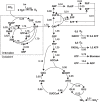Fluxomics - New Metabolomics Approaches to Monitor Metabolic Pathways
- PMID: 35387341
- PMCID: PMC8977530
- DOI: 10.3389/fphar.2022.805782
Fluxomics - New Metabolomics Approaches to Monitor Metabolic Pathways
Abstract
Fluxomics is an innovative -omics research field that measures the rates of all intracellular fluxes in the central metabolism of biological systems. Fluxomics gathers data from multiple different -omics fields, portraying the whole picture of molecular interactions. Recently, fluxomics has become one of the most relevant approaches to investigate metabolic phenotypes. Metabolic flux using 13C-labeled molecules is increasingly used to monitor metabolic pathways, to probe the corresponding gene-RNA and protein-metabolite interaction networks in actual time. Thus, fluxomics reveals the functioning of multi-molecular metabolic pathways and is increasingly applied in biotechnology and pharmacology. Here, we describe the main fluxomics approaches and experimental platforms. Moreover, we summarize recent fluxomic results in different biological systems.
Keywords: flux; fluxomics; mass spectrometry (MS); metabolomics; nuclear magnetic resonance (NMR); pharmacometabolomics.
Copyright © 2022 Emwas, Szczepski, Al-Younis, Lachowicz and Jaremko.
Conflict of interest statement
The authors declare that the research was conducted in the absence of any commercial or financial relationships that could be construed as a potential conflict of interest.
Figures








References
-
- Alahmari F., Dey S., Emwas A.-H., Davaasuren B., Rothenberger A. (2019). Layered Copper Thioaluminate K2Cu3AlS4: Synthesis, crystal Structure, Characterization and Solid-State 27Al and 39K NMR Studies. J. Alloys Comp. 776, 1041–1047. 10.1016/j.jallcom.2018.10.239 - DOI
-
- Aon M., Cortassa S. (2015). Systems Biology of the Fluxome. Processes 3 (3), 607–618. 10.3390/pr3030607 - DOI
Publication types
LinkOut - more resources
Full Text Sources

